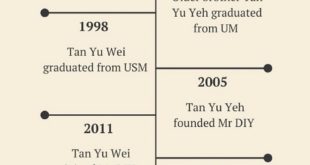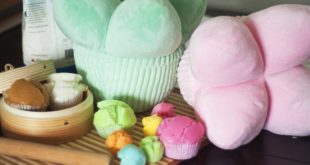Author’s Blurb: I quite like the look of vintage clothing, but don’t think I can pull it off. I do follow some people online who take the lifestyle rather seriously, however, though I’ve never met anyone who’s on the other side of the picture: the ones restoring these vintage clothing items.
Jackie Heng and Wendy Neoh are a mother-daughter duo who operate Heritasia Crafts, a home business where they essentially restore vintage dresses, skirts, and more to their former prime to sell to those living the vintage fashion lifestyle.
What we’re talking about here is real vintage clothing, not just vintage inspired or vintage style clothing. But how does one even tell the difference?
“For clothes to be considered as vintage, they have to be at least 20 years old. Our vintage dresses are mostly from the 1970s right up to the 80s and some in the 90s too. So that means our dresses could be as old as 50 years old,” Wendy told Vulcan Post.
After having done this for years now, she’s learnt some telltales for determining the authenticity of a vintage piece:
- The way the clothes labels are printed, their material, and brand names,
- Vintage clothing usually has superior quality (workmanship and fabric) and was made to last,
- Design features like pin-tucking, smocking, pleating, lace and embroidery, and sometimes they come with matching belts and buckles,
- The types and designs of accessories that come with the clothing (buckles and buttons),
- The overall aesthetic of the clothing based on its shape/silhouette.
The clothing that Heritasia Crafts works with are sourced both overseas and locally, whether through their own travels or that of contacts’.
“We keep a look out for any thrift shops (including the Salvation Army, charity shops, etc.), vintage/antique shops, to even car boot sales or someone’s old closet!” Wendy said.
Finding A Fix
However, despite the fact that Wendy mentioned vintage clothing is usually made to last, some pieces will undoubtedly fall victim to external factors.
While she and her mother don’t shy away from challenging and time-consuming restoration/repair works, they still have to balance their passion for vintage clothing with the business side of things.
“Sometimes we do find ourselves biting more than we can handle—we have had a few instances where we brought back pieces we thought we could restore but couldn’t in the end,” Wendy said.
“That is the risk that we are willing (or have) to take as vintage sellers. It pushes us to be creative in our process.”
In being creative, they’ve transformed dresses into skirts and shortened long sleeves to short ones when they find holes or insect bites on the fabric.
They limit these transformations as much as possible though, and will only do so if it’s the only way a piece can be salvaged.
This is where Jackie’s 40+ years of experience as a seamstress comes in to save the day, and allows them to take higher risks when purchasing vintage pieces.
After the purchase, the restoration process starts with a good wash (and surprisingly, you’d wash vintage clothing with the same precautions you’d take with modern clothing) before the item is hung to dry.
Next comes the check for stain removals and a quality check to confirm what needs to be done.
Some of the most common repair works include changing elastic waist bands, replacing buttons, buckles, zippers and studs, and re-hemming skirts and collars, to name a few.

This entire process will take 3 to 4 hours per piece, excluding the time taken for sourcing, washing and steam ironing them.
Wendy also shared that beyond repairing, they try to add value to the clothing.
For example, they might make belts for some of the dresses, and though these are additional costs to the overall process, they make the pieces ready to wear and are often appreciated by their customers.
Keeping The Love Of Vintage Alive
Aside from selling their selected pieces online, they set up booths at markets and bazaars where they can talk to customers about vintage clothing in person. Thus far, a majority of their customers are women in their mid-20s to mid-40s.

Wendy and Jackie are also transparent about the flaws that some of their pieces might still have despite their best efforts, and in most cases, customers fully accept these flaws as part of authentic vintage pieces.
The prices for tops, jackets, skirts and culottes begin at RM29, while dresses are usually priced RM89 and above.

Whenever they’re approached by people who ask why their pieces tend to be on the pricier side than other sellers, Wendy will explain the process in making these vintage pieces ready to wear.
“Rentals for pop-up booths have steadily increased over the years too. These are some of the hidden costs that people or our customers don’t see/think of,” she shared, adding that sourcing for vintage clothing and accessories is also becoming increasingly difficult.
Behind keeping the love for and lifestyle of vintage clothing alive, Wendy sees what they do as part of keeping textile waste out of landfills too.
“It is such a wonderful feeling to restore these pieces back to their glorious days, to be once again enjoyed and re-loved,” she said. The great response they get from customers also makes all their efforts in going the extra mile worth it.
Nonetheless, she admitted that business wasn’t rosy all the time. In the initial stage, they had to understand the local market’s preferences and be able to gauge which pieces would appeal to them and sell.
Despite more people starting to understand vintage clothing, they still encounter people who are against the idea of wearing clothes that have been worn by others.
“So, it is important to keep the discussion going—we hope that more and more people will say no to fast fashion and opt for past fashion instead!” Wendy said.
Bottom Line: I have no doubt that vintage restoration is tough work—to me, it even qualifies as an art. Sometimes I think fixing something can be much harder than just starting something from scratch, especially when you’re trying to keep the original essence of the work.
- You can read about other Malaysian startups here.
Featured Image Credit: Heritasia Crafts





